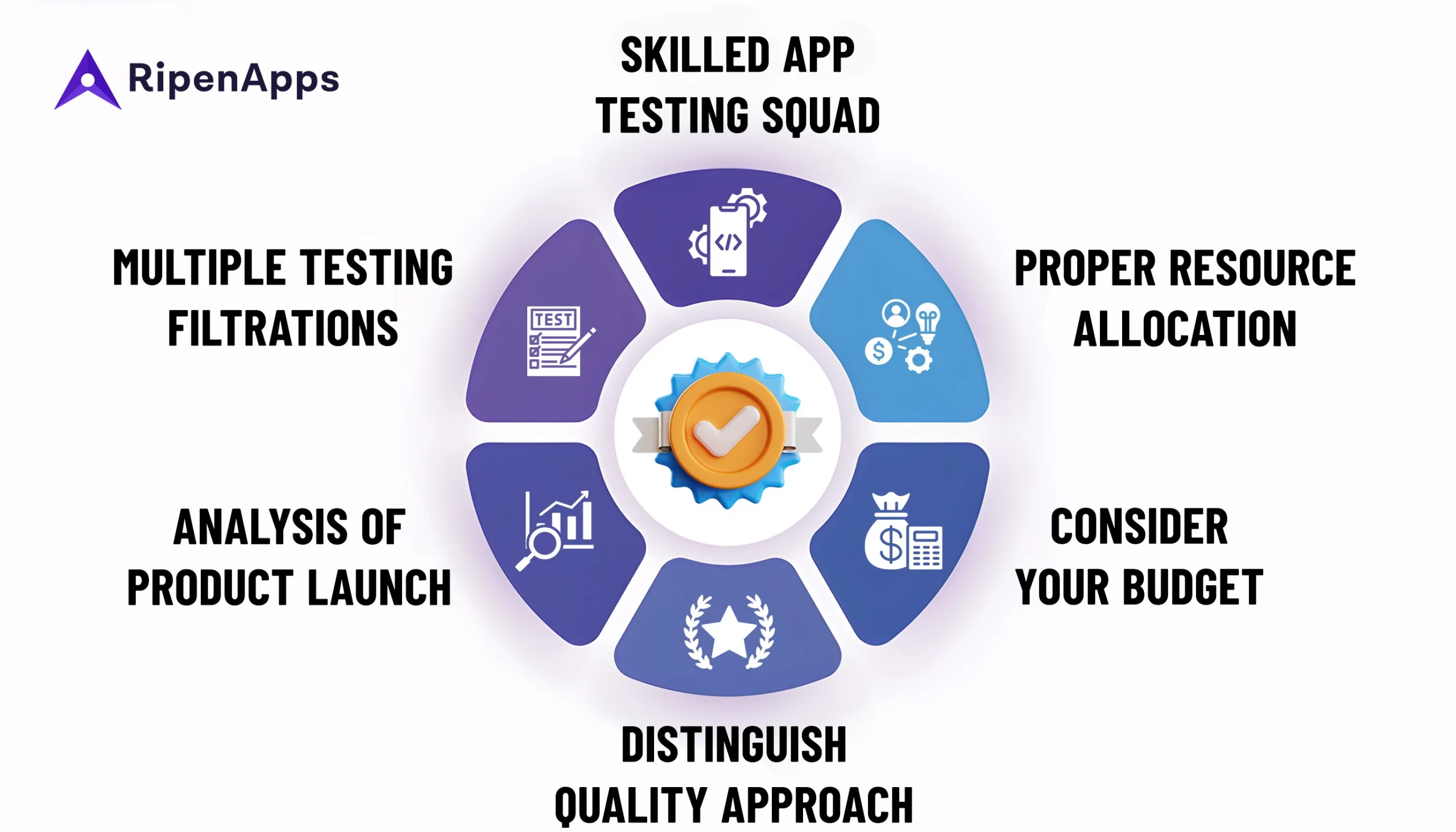In the present age of a mobile-first world, you don’t get a second chance at a first impression. Users expect flawless performance, instant responsiveness, and zero friction. And if your app doesn’t deliver? They’ll delete it before your loading spinner finishes its first spin.
That’s where Quality Assurance (QA) becomes a deal-maker, not just for the tech team, but for the entire business strategy.
And yet, many businesses still treat quality assurance as an afterthought, assuming developers will “catch issues later as they go”. But real, growth-focused brands know better. Therefore, mobile app quality assurance is more than a technical checklist. It is a competitive edge built into every pixel, API, and interaction from day one.
In this blog, we’ll explore eight proven QA methods that safeguard your app’s performance, user trust, and return on investment (ROI). From automated testing to real-world device labs, we’ll cover what leading companies are doing to ensure that when your app goes live, it actually works and captures users’ attention.
Table of Contents
What is Mobile App Quality Assurance?
Quality assurance (QA) in mobile app development confirms your app’s quality and ensures smooth business operations. The effective quality assurance allows businesses to begin to trust your name as a symbol of quality and recommend your products to others.
And, for improving mobile application quality assurance on the scale of “Good to Great“, proper strategized steps must be taken.
This is because throwing more money, people, and effort at a quality problem without the right strategy won’t work. Thus, for deploying a well-built app in the market, Quality is an aspect that shouldn’t be compromised in any case.
Why Quality Assurance in Mobile App Development Actually Matters?
In a market where users expect speed, beauty, and bug-free interaction all at once, quality assurance in software development is no longer just a technical best practice. It has now become a business necessity. 88% of users will abandon an app if they encounter any bugs or technical problems during usage. 96% of global SMEs estimate the loss of up to $2.49 million due to poor mobile application quality. Therefore, quality assurance in mobile app development directly affects business revenue and its reputation. Here’s why smart teams embed QA into their mobile app strategies from the very beginning.
1. First Impressions Are Final Downloads
The truth? Most users won’t give you feedback. They’ll just uninstall.
The App Store is brutal like that. One broken button, one crash during checkout, or one lag on an older device, and you’ve lost that user forever. Good QA ensures your app not only looks good but also performs flawlessly across real-world conditions. And in the hands of a custom app development company, this translates into intuitive UX that actually works on day one.
2. Bugs Can Damage Your ROI
Every undetected issue in your app is a ticking revenue leak. Whether it’s a payment gateway bug, a notification misfire, or data not syncing across screens, small cracks can cost big money. When you integrate mobile application QA tools early in the dev cycle, you can prevent these expensive mishaps.
3. Performance = Retention = Revenue
You can’t scale what doesn’t perform. Even if you spend heavily on paid user acquisition, users will bounce if the app lags or drains battery like a black hole. QA ensures your app is free from all kinds of technical errors and bugs. From load time to screen rendering to battery impact, performance-focused testing improves long-term retention, and that’s where your real LTV is built.
4. Data Security Is a Major User Concern
In sectors like fintech, healthcare, or government tech, even a small security lapse can invite regulatory trouble or worse, customer distrust. This is where mobile app quality assurance helps you strengthen data security and user privacy in the mobile app. It performs penetration tests, data validation, and authentication flows to ensure airtight protection. That’s especially vital when you’re building products for compliance-sensitive regions like the US, UK, and UAE.
5. QA Speeds Up Delivery
The old-school view of QA as a “final phase” is outdated. Real efficiency happens when QA is baked into every sprint, catching bugs before they become roadblocks. Modern QA workflows, coupled with automation and smart tools, allow teams to ship faster and with confidence. And the best part? The earlier you invest in QA, the less you spend fixing things later.
Ways To Ensure Quality Assurance in Mobile App Development

1. Well-Versed App Testing Squad
A squad testing of mobile applications that encompasses a huge quantity of expertise and skills ought to be appointed for Quality Testing purposes. If the team members have a good set of testing skills, they will tackle any quality issue to achieve the desired result.
Also, the team members ought to be able to take a look at cases that stand out as the core element in QA mobile testing criteria. Further, identification of requirements, fixing the bugs, and method planning should be inculcated by the respective team. They can also keep track of the app in the testing phase.
2. Multiple Testing Filtrations Before Final Launch
Testing is composed of a dozen techniques: Integration, Regression, Load, Stress, Localization, and system testing form the basis of any testing method. With the assistance of online QA mobile testing, testers determine the issue, resolve the bug then move to any assessment.
The more an app passes through the tests, the higher the possibility of it winning within the app market. Therefore, you should seek high-standard mobile app development services that covers high-standard quality assurance and conduct multiple tests before the final launch.
3. Real-Device Testing > Emulators
While simulators work on speed, end-users do not use simulators-they use the actual devices with real glitches, screen sizes, memory limits, and OS quirks.
Good glitch testing for any applications at all requires a competent engineer to perform genuine real-world scenario tests-worst internet, low battery, and OS interruptions, every actual device, from the budget Android phones through to those old iPhones and foldables. If your app can fight through these trials, it is capable of fighting through anything.
4. Quality Analysis on Product Launch
If you’re an application quality analyst/tester-expert, you already recognize that you simply are loaded with a euphemism for responsibilities that ought to be consummated before the app launch. Thus, mobile application quality assurance may be a criterion that ought to receive special attention compared with the opposite one.
Right before the app launch, analyzing the standard aspects with some quality tools will ease the danger of app failure within the app market. Moreover, you must hire an experienced application quality analyst/tester-expert to conduct quality analysis before the launch of your product.
5. Distinguish Quality Approach in Startups & Enterprises
Startups and Enterprises are in contradiction with each other. Each Enterprise was once a startup that worked onerous to achieve the heights and success they continuously desired.
Hence, if there’s a startup company, they’ll invest in some short-term goals for quality management and work on every minute detail to realize the simplest out of it.
For enterprises, the operating method changes a touch. They need an additional vital budget where there are several investors, product quality analysts, and quality management is performed on a larger scale. As much as QA cares, it must contour its processes and keep each of them nimble and relevant.
6. Cover All Platforms with Equal Depth
It’s tempting to give iOS the premium treatment and let Android catch up later. But that’s a mistake, especially in markets like India or the UAE, where Android dominates. Android mobile app quality assurance should be treated with the same priority, detail, and tooling as iOS. Platform parity is a brand experience standard. And if you’re working with a team offering iphone app development in India, make sure they have dedicated Android QA engineers, not just iOS testers doubling up.
7. Consider Your Budget for QA
An adequate budget is required to check the quality of the associate app successfully. As investors, individuals ought to deploy a budget that is versatile and that doesn’t run out of money under any circumstances.
Under a tight budget, it becomes difficult for the developers to travel altogether styles of comprehensive testing of mobile applications. Thus, if the efforts fail, it will leave a foul name on them.
Overall, it goes hand in hand. If the shoppers desire a quality mobile app, they’ll offer a wonderful budget that is versatile in each section of mobile app development. Also, along with QA, if you want to include additional features such as UI/UX designing, then your overall budget for the project may increase.
8. Need a Proper Resource Allocation
For a winning app quality assurance, there ought to be an associate professional QA associate between every four developers, and it’ll rely upon the quantity of demand as well as options. During an essential case, the project may need automated regression testing and would like the extra resources.
Also, at the top of every sprint, testing ought to be done on a daily basis. At last, the app launch strategy ought to be stable beforehand, as there could be cases when you ought to launch an associated app at the regular time. Thus, correct resource allocation may be a must for the efficient running of the standard analysis method.
9. Automate, But Don’t Over-Automate
Automation tools are a gift, especially for regression, load, and performance testing. They free up your QA team to focus on strategic testing and edge cases.
But automation has limits. A login might work fine in a script but break when a user pastes in an emoji. That’s why the most successful QA strategies combine automation with sharp manual testing, especially for UI/UX flows.
Many startups working with a UI UX design agency now loop in QA engineers early to validate not just aesthetics, but usability and user behavior friction points.
Read Also : Factors that Will Determine Mobile App Development Cost in 2025
How Quality Assurance Can Reduce Mobile App Development Cost?
Let’s clear up a myth: QA doesn’t increase cost. Actually, it controls it. In fact, quality assurance in mobile app development is one of the smartest ways to stay within budget without cutting corners. While skipping QA might look cheaper on a spreadsheet, in reality, it opens the floodgates for post-launch bugs, crash-driven churn, and painful rework cycles that cost way more, both in money and in brand reputation. Here’s how smart QA actually helps you save.
1. Early Bug Detection = Cheaper Fixes
The cost to fix a bug increases with the later stages of detection. For example, a logic flaw discovered during the design phase may require only a few hours to fix. If found after launch, it could mean having to re-engineer entire workflows, delay updates, or pay out refunds.
In sprint one, mobile app testing should be put into the mix to allow the team to find bugs when they still cost little to fix. It’s like the difference between plucking a hair and major surgery.
2. Preventing App Store Rejections
Nothing stalls your go-to-market momentum like getting rejected by Apple or Google due to a crash, privacy issue, or broken functionality. Each rejection means more dev time, more fixes, and more testing cycles, adding hidden layers to your mobile app development cost.
QA ensures your app meets platform guidelines on the first try, helping you launch clean, fast, and with full compliance.
3. Avoiding Costly Post-Launch Support
If the app crashes even once and is not caught pre-launch, it goes directly to the customer’s issue queue. Now your developers are busy firefighting, while the support team is overwhelmed with user complaints, with users taking to Twitter to vent their frustrations.
Mobile application QA reduces support issues by making sure the application is stable from the very start. It means fewer complaints, less patching, and a clear product roadmap for the company-not one that’s constantly being forced to deal with emergency hotfixes.
4. Performance Optimization = Less Infrastructure Cost
QA means more than just looking for bugs. Performance optimization is the name of the game. Actually tested applications use less bandwidth, load faster, and consume fewer backend resources, which directly comes as great savings-as you scale, that is.
And in an area that demands expensive backend resources such as real-time tracking, eCommerce, or ride-hailing, optimized milliseconds weigh heavily.
5. Help Your Development Team Think Innovative
A strong QA feedback loop enables developers to produce cleaner, more modular code with far fewer rewrites and guesses, so that the team can move systems forward faster and with confidence. This is great engineering, and it is great product building. For growth-driven teams, it is how you achieve more with less.
Conclusion
Today’s users don’t just expect your app to work. They expect it to work flawlessly, across every device, OS version, and interaction. And if it doesn’t? They uninstall, leave a 1-star review, and move on.
So if you’re aiming for product-market fit, long-term retention, and meaningful ROI, you need a high-standard quality assurance to make sure your app performs flawlessly and drives good ROI.
And RipenApps is one such expert mobile app development company that specializes in building high-class mobile apps with top-notch features, with full quality assurance.
FAQs
Q1. What is the importance of Quality Assurance (QA) in mobile app development?
QA ensures the mobile app behaves in a reliable and secure way while doing what it intends to do on all devices and platforms. It enables early detection of bugs, reduces the cost of rework, enhances user experience, and builds a good name for the customer.
Q2. What are some proven QA methods used in mobile app development?
Here are some effective QA techniques one can deploy:
- Manual Testing (For UI/UX and exploratory scenarios)
- Automated Testing (Regression and repetitive tests)
- Unit Testing (For checking individual components)
- Integration Testing (For checking interaction between modules)
- Performance Testing (For speed and stability)
- Security Testing (For vulnerabilities)
- Usability Testing (For user-friendliness)
Q3. How does automated testing contribute to mobile app QA?
Automated testing accelerates mobile app QA by swiftly executing test cases on various environments and devices. It improves test coverage, finds regressions fast, results in consistent outcomes, and thus, allows quicker releases- a prerequisite for scalable agile development.
Q4. What role does usability testing play in mobile app QA?
Usability testing guarantees that real users navigate and use the system intuitively and efficiently. It finds barriers in UI/UX and accessibility and friction points in the user journey, hence enhancing retention, engagement, and satisfaction.











 India
India USA
USA Australia
Australia Canada
Canada UK
UK UAE
UAE
